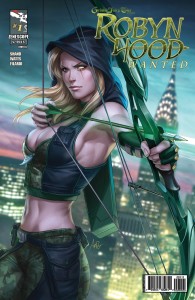 Zenescope are at it again with Robyn Hood: Wanted #1, kicking off the second arc of Robyn Locksley’s tale. Robyn is a woman from our world, who’s been transported to the magical realm of Myst and becomes the female version of the famous archer. What’s so disappointing about this book, though, isn’t the storytelling or the way the female lead is treated. The narrative here is well crafted, written exactly the way the beginning of a sequel should be. Robyn has returned to Earth after defeating the evil King John, but here she’s a hunted woman, wanted for murder by people who don’t understand her true heroic nature. Writer Patrick Shand (Angel, Godstorm) has created a warrior with a lot of pent up anger, which she directs at her long abusive father. Artist Larry Watts draws Robyn as a gritty young woman with little flash, more a compact blond ball of anger than a bombshell in the traditional sense. Zenescope’s standard, sexualized treatment of its characters is present, largely on the cover of the book, but it’s all made worse by the incentive covers gallery, featuring a limited edition cover picturing Robyn completely nude except for her bow and arrow. This kind of marketing makes it hard to take an otherwise OK book seriously.
Zenescope are at it again with Robyn Hood: Wanted #1, kicking off the second arc of Robyn Locksley’s tale. Robyn is a woman from our world, who’s been transported to the magical realm of Myst and becomes the female version of the famous archer. What’s so disappointing about this book, though, isn’t the storytelling or the way the female lead is treated. The narrative here is well crafted, written exactly the way the beginning of a sequel should be. Robyn has returned to Earth after defeating the evil King John, but here she’s a hunted woman, wanted for murder by people who don’t understand her true heroic nature. Writer Patrick Shand (Angel, Godstorm) has created a warrior with a lot of pent up anger, which she directs at her long abusive father. Artist Larry Watts draws Robyn as a gritty young woman with little flash, more a compact blond ball of anger than a bombshell in the traditional sense. Zenescope’s standard, sexualized treatment of its characters is present, largely on the cover of the book, but it’s all made worse by the incentive covers gallery, featuring a limited edition cover picturing Robyn completely nude except for her bow and arrow. This kind of marketing makes it hard to take an otherwise OK book seriously.
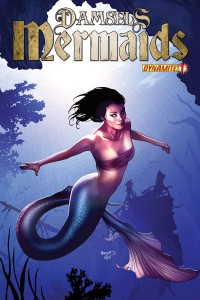 Dynamite Entertainment does a slightly better job with Damsels: Mermaids #1. (Yes, the Mermaid of the title is topless in a least one variant cover, but that’s a common trope in mermaid art, as mermaids are creatures of the sea and don’t own clothes, apart from the occasional shell bikini.) This mermaid is presumably the same “Little Mermaid” from their Free Comic Book day #0 issue, but the story begins anew here. The unnamed mermaid (she’s very serious about not revealing her name) is a despondent young woman, willing to take on schools of sharks to help out a selkie (a shape shifting seal-like mer-creature) with no thought to her own life. Indeed, her life is something she’d gladly give away, having had her heartbroken in the distant past. She sees little future for herself until she meets the exiled Prince John, castaway on her island. She decides to help him in his quest to throw off Atlantean rule of his homeland, out of hatred for the Atlantean oppressors and not, thankfully, because she’s become starry-eyed over the Prince. Her bitterness permeates the book, and she’s one of the very few fully developed characters in the story. The Prince himself, like all Princes in such stories, seems too good to be true, though in this somewhat dark tale, that may bode for an interesting twist along the way. The book has that feel more than any other, that there’s something happening that you don’t expect all along, and it makes for an interesting read.
Dynamite Entertainment does a slightly better job with Damsels: Mermaids #1. (Yes, the Mermaid of the title is topless in a least one variant cover, but that’s a common trope in mermaid art, as mermaids are creatures of the sea and don’t own clothes, apart from the occasional shell bikini.) This mermaid is presumably the same “Little Mermaid” from their Free Comic Book day #0 issue, but the story begins anew here. The unnamed mermaid (she’s very serious about not revealing her name) is a despondent young woman, willing to take on schools of sharks to help out a selkie (a shape shifting seal-like mer-creature) with no thought to her own life. Indeed, her life is something she’d gladly give away, having had her heartbroken in the distant past. She sees little future for herself until she meets the exiled Prince John, castaway on her island. She decides to help him in his quest to throw off Atlantean rule of his homeland, out of hatred for the Atlantean oppressors and not, thankfully, because she’s become starry-eyed over the Prince. Her bitterness permeates the book, and she’s one of the very few fully developed characters in the story. The Prince himself, like all Princes in such stories, seems too good to be true, though in this somewhat dark tale, that may bode for an interesting twist along the way. The book has that feel more than any other, that there’s something happening that you don’t expect all along, and it makes for an interesting read.
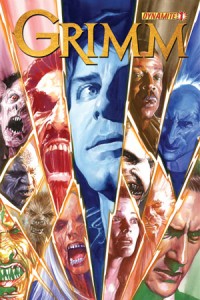 Dynamite isn’t done with us this week, or with fairy tales for that matter. Their other #1 is a comic spin-off from the NBC television series Grimm. Detective Nick Burkhardt is a Grimm, someone who can see all the fairy tale monsters our parents read us stories about. However, they are very real, and have been waging an underground war for centuries. Nick and his companions are now on a mission to recover three magical coins that hold power over mankind, apparently. This book is a pretty straightforward but interesting entrance point for those who don’t watch the television show, although it suffers a bit by being part of a TV show. It has that feeling, in the very first chapter, of a TV series that’s already jumped the shark, filled with more characters than are really necessary (and poorly developed because of it) and plot twists that border on ludicrous. It also introduces new characters, including Nick’s long lost mother, a Grimm herself, and a second female Grimm who saves Nick’s bacon against a group of werewolves in formidable hand to hand combatant. The unnamed character doesn’t even have a line in the comic – just a dramatic, nearly naked entrance. Yawn.
Dynamite isn’t done with us this week, or with fairy tales for that matter. Their other #1 is a comic spin-off from the NBC television series Grimm. Detective Nick Burkhardt is a Grimm, someone who can see all the fairy tale monsters our parents read us stories about. However, they are very real, and have been waging an underground war for centuries. Nick and his companions are now on a mission to recover three magical coins that hold power over mankind, apparently. This book is a pretty straightforward but interesting entrance point for those who don’t watch the television show, although it suffers a bit by being part of a TV show. It has that feeling, in the very first chapter, of a TV series that’s already jumped the shark, filled with more characters than are really necessary (and poorly developed because of it) and plot twists that border on ludicrous. It also introduces new characters, including Nick’s long lost mother, a Grimm herself, and a second female Grimm who saves Nick’s bacon against a group of werewolves in formidable hand to hand combatant. The unnamed character doesn’t even have a line in the comic – just a dramatic, nearly naked entrance. Yawn.
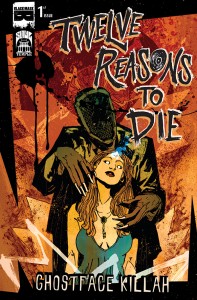 The misogyny and violence roll on with the unusual new book from Black Mask Studios, Twelve Reasons to Die #1. The book “features” the Wu-Tang Clan’s Ghost Face Killah, and he’s depicted here in his alter-ego of Anthony Starks (whom Ghost Face Killah aped form Ironman’s alter ego Tony Stark). GFK is given a “Created by” credit along with music producer and writer Adrian Younge, and the six-part series is intended to be a companion piece to GFK’s upcoming album of the same name. The story begins with a disjointed account of several rather pragmatic and ruthless men taking over organized crime in Italy after World War II. They engage in some gratuitous violence and reprehensible behavior with women, before Starks enters the scene. Then the story inexplicably shifts to modern times, where a wealthy recluse has paid a young man named Mr. Migdal to nab a rare record for him. This record has mystical properties, apparently, and is one of 12 in the world that seem to bring about untimely deaths to those who listen to them. There’s not a lot a narrative unity or flow in this book, but it’s still a compelling read. The underlying connections (with the exception of an odd interlude involving sheep, wedged between the two stories) are implied fairly clearly, and it seems that young Mr. Migdal, who refers to himself as a professional “crate digger”, is the main character. Further reading will be necessary to make sure that’s really the case, and I have to admit, this kind of crossover musical concept had me searching iTunes for the titular album, a match to the comic book with its violent thematic lyrics.
The misogyny and violence roll on with the unusual new book from Black Mask Studios, Twelve Reasons to Die #1. The book “features” the Wu-Tang Clan’s Ghost Face Killah, and he’s depicted here in his alter-ego of Anthony Starks (whom Ghost Face Killah aped form Ironman’s alter ego Tony Stark). GFK is given a “Created by” credit along with music producer and writer Adrian Younge, and the six-part series is intended to be a companion piece to GFK’s upcoming album of the same name. The story begins with a disjointed account of several rather pragmatic and ruthless men taking over organized crime in Italy after World War II. They engage in some gratuitous violence and reprehensible behavior with women, before Starks enters the scene. Then the story inexplicably shifts to modern times, where a wealthy recluse has paid a young man named Mr. Migdal to nab a rare record for him. This record has mystical properties, apparently, and is one of 12 in the world that seem to bring about untimely deaths to those who listen to them. There’s not a lot a narrative unity or flow in this book, but it’s still a compelling read. The underlying connections (with the exception of an odd interlude involving sheep, wedged between the two stories) are implied fairly clearly, and it seems that young Mr. Migdal, who refers to himself as a professional “crate digger”, is the main character. Further reading will be necessary to make sure that’s really the case, and I have to admit, this kind of crossover musical concept had me searching iTunes for the titular album, a match to the comic book with its violent thematic lyrics.
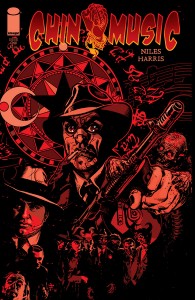 Mobsters and violence are an ongoing theme in our last two #1’s this week. Image’s Chin Music #1 is set in the real-life gang wars of the 1930’s between Elliot Ness and Al Capone, with an element of supernatural thrill added to the tale. Its main character, Shaw, is a seemingly immortal practitioner of some very dark magic, plying his trade as a pistol toting mob heavy. He’s able to take out Al Capone with a single magical bullet, all after having most of his skin flayed off by demons. This book is graphically violent to a point that makes it almost campy. Sadly, the demonic back story of Mr. Shaw is a little thin, and it makes it hard to decide if the reader should root for him or be very, very afraid. This book ultimately has the feel of an interesting gimmick that’s not very well fleshed out (pun intended.)
Mobsters and violence are an ongoing theme in our last two #1’s this week. Image’s Chin Music #1 is set in the real-life gang wars of the 1930’s between Elliot Ness and Al Capone, with an element of supernatural thrill added to the tale. Its main character, Shaw, is a seemingly immortal practitioner of some very dark magic, plying his trade as a pistol toting mob heavy. He’s able to take out Al Capone with a single magical bullet, all after having most of his skin flayed off by demons. This book is graphically violent to a point that makes it almost campy. Sadly, the demonic back story of Mr. Shaw is a little thin, and it makes it hard to decide if the reader should root for him or be very, very afraid. This book ultimately has the feel of an interesting gimmick that’s not very well fleshed out (pun intended.)
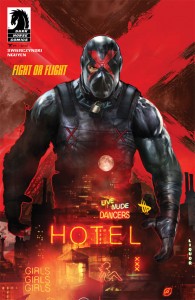 Lastly, Dark Horse Comics follows up their recent issue #0 with X #1. These two books could really have been numbered #1 and #2, as this book relies heavily on the material from the earlier issue. Uber-violent vigilante X is taking on both the mob and a corrupt police force, and he has help this time around from a self described muckraking blogger named Leigh Ferguson. The pink-haired punk writer Ferguson is really the most compelling character in this story, and though her reporter instincts seem like a combination of naiveté and deus ex machina, she’s a determined young woman who’s ready to harness the power of her readers to help X in his quest, despite her shock that X is in fact a real person. Leigh has a grim sense of humor that goes well in this dark and violent book, but she’s not very well rounded, and seems to serve little purpose beyond narrating the story.
Lastly, Dark Horse Comics follows up their recent issue #0 with X #1. These two books could really have been numbered #1 and #2, as this book relies heavily on the material from the earlier issue. Uber-violent vigilante X is taking on both the mob and a corrupt police force, and he has help this time around from a self described muckraking blogger named Leigh Ferguson. The pink-haired punk writer Ferguson is really the most compelling character in this story, and though her reporter instincts seem like a combination of naiveté and deus ex machina, she’s a determined young woman who’s ready to harness the power of her readers to help X in his quest, despite her shock that X is in fact a real person. Leigh has a grim sense of humor that goes well in this dark and violent book, but she’s not very well rounded, and seems to serve little purpose beyond narrating the story.


I have a question that doesn’t exactly pertain to the comic books listed above, but about comic books more broadly. I hope it’s ok for me to ask it here. My question is this: do all comic book series eventually get compiled into trade paperbacks, or does it depend on the series?
Hi Joss. Rick weighed in on your question on our Tumblr.